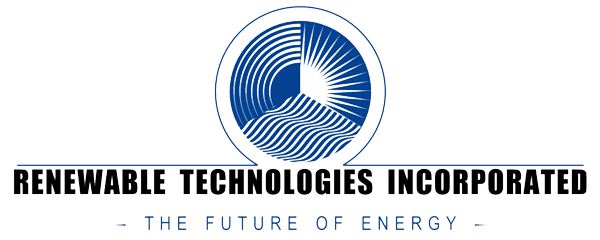Did you know that renewable energy is the fastest-growing source of electricity in the world? In fact, it accounted for nearly half of all new capacity added to the global grid in 2017. If you’ve been thinking about transitioning to solar power, it has never been so efficient, so affordable, and so likely to produce a financial return on your investment! In this article, we will discuss what renewable energy is, common sources of renewable energy, and why you should invest in solar power over another renewable energy source.
What Is Renewable Energy?
According to the United Nations, renewable energy is defined as “energy derived from natural sources that are replenished at a higher rate than they are consumed.” The first example they cite as a renewable energy source is solar power—though there are a handful of other types of renewable energy technologies as well.
The crucial benefit of investing in renewable energy is that it transitions us from “dirty” sources of fuel—like gas, oil, coal, and other fossil fuels—which are finite resources on the planet and the product of hundreds of millions of years in the making. Our reliance on fossil fuels is one of the primary producers of greenhouse gas emissions, contributing to our current climate crisis.
Renewable energy creates far less emissions than our reliance on fossil fuels—and some, like solar power, create no emissions at all. Fortunately, the infrastructure around renewable energy is growing, as the industry now creates three times the amount of jobs as older, outdated energy sources. This has the twofold benefit of making it more affordable for the average citizen as well, making it all the easier to make the switch. And even if you’re not interested in saving the planet, you might be interested in saving money—and investing in renewable energy like a solar system for your home or business can come with a litany of financial incentives.
What Is the Most Common Renewable Energy Source?
In the United States and across the world, hydropower dominates the renewable energy scene producing thousands of terawatt-hours (TWh) across the globe. Making up over 60% of all renewable energy across the planet, this renewable energy source is most commonly relied upon in China, followed by the United States, Canada, and Brazil.
As of 2017, a whopping 19 U.S. states relied on hydroelectricity as their primary source of renewable energy, with second place being wind-generated power in 16 states. And while hydroelectricity is one of our most trusted sources of renewable energy, the industries of wind and solar power are rapidly growing as the technology and efficiency of the equipment continues to improve. Other sources of renewable energy include:
- Geothermal energy: This type of energy relies on the radiant thermal energy coming from Earth’s core. There are two primary ways of harnessing this energy: through hydrothermal reservoirs (which provide a source of heat for water tanks or homes) or through enhanced geothermal systems, which is a hydrothermal reservoir with the addition of hydraulic stimulation. These systems rely on steam or hot water to generate electricity at their energy processing source, whether that be at a flash steam power station, dry steam power station, or a binary cycle power station. For reference, the United States is the number one global producer of geothermal power, producing nearly 17 billion kilowatt hours (KWh), with the second largest producer being Indonesia.
- Tidal or ocean energy: This form of renewable energy comes from both the thermal and kinetic energy of the water, harnessing both heat and electricity from the natural motions of the ocean. This is a relatively new type of renewable energy and is still developing—though it has tremendous potential to meet all human energy demands. Currently, there are a few prototype technologies for harnessing kinetic energy from tidal currents and waves.
- Biomass energy or biofuels: This form of renewable energy is produced from organic material such as manure, wood, or agricultural crops as a means of producing heat, power, and biofuels. This type of technology is frequently used in developing countries and, while there is still a carbon footprint associated with burning these biofuels, it emits lower levels of greenhouse gases than traditional fossil fuels. As of 2017, eight American states relied on biomass as their primary renewable energy source, taking what would otherwise be waste from forestry, ranching, or agrarian endeavors into fuel.
Why Invest in Solar Over Other Alternative Energies?
With a number of different alternative energies to choose from, what are the advantages of picking solar to invest in over the rest? In the following section, we will break down some of the key benefits of investing in solar over other renewable energy sources.
- The sun is the ultimate source of energy for life on earth. Since the beginning of life forms as we understand them, the sun has been the catalyst for spurring bacteria, algae, plants, and the creatures that eat those things (and the creatures that eat those things) to continue to thrive. Plants have already figured out how to tap into this resource through photosynthesis, relying on the sun’s rays to provide them the energy to continue growing and casting seeds until they die. Did you know that the amount of solar energy that touches the surface of the earth in 60 minutes is more than enough to supply the entire planet with the energy it needs for an entire year? The magnitude of this resource cannot be overstated.
- The infrastructure is one of the fastest growing renewable energies in the world, creating new jobs. By investing in solar energy, you are making the choice to invest in renewables, creating infrastructure for clean energy and the jobs to go with them. Solar power is one of the fastest growing renewable energy sources—and while only seven U.S. states relied mostly on solar power in 2017, in 2022, solar power will contribute a whopping 46% to the total energy generation for America, beating out nuclear energy, natural gas, and wind.
- The cost of installation and maintenance is going down each year. In fact, solar power went from the most expensive renewable energy option about a decade ago to one of the most affordable, with a price drop of about 90%. What’s more, solar panels are the cheapest form of renewable energy to install, even beating out wind power in price as of 2020. While a one-watt capacity of solar power used to cost $1,825 back in the 1950s when NASA began refining the technology, today it costs closer to $0.70 per watt.
- It produces zero carbon emissions. Unlike other renewable energy sources that still produce some greenhouse gas emissions, such as biomass, solar energy produces no carbon emissions. This not only means better things for our health, environment, and planet, but likely provides tax breaks and other financial incentives to get on board as well. This is a particularly palatable option for businesses looking for ways to bolster their bottom line and achieve good PR at the same time.
- They pay for themselves. Some people might see the price of the initial cost of installation of a solar power setup and rule it out; however, solar panels typically pay for themselves in six to ten years. What’s more, any extra energy you are able to capture that you don’t use can be sold to your local power company and you may even turn a profit! If you are interested in learning about other ways solar power can save you money, check out this resource on government incentives in the form of solar power tax credits!
Choose Solar as Your Renewable Energy Source with Our Team of Professionals
The world is in the process of shifting from outdated, harmful fossil fuels to more efficient, sustainable technologies. Much has changed since the first hydroelectric power plant began in Appleton, Wisconsin in the late 1800s—and while we still rely on hydroelectric power to a great degree to this day, the landscape of our renewable energy infrastructure is changing. As solar power becomes more efficient, more affordable, and more popular, it’s no wonder that it’s expected to contribute nearly half of the United States’ energy needs in 2022. The question is, are you ready to transition to this next chapter for the energy sector?
Want to talk with our team of professionals about what a solar setup would look like for your business? Contact Renewable Technologies today for a quote!

